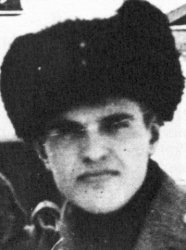Swedish Voluntary Aviators


Furir Bengt Johan Matti Sundstén
24 February 1917 – 8 April 1977
Matti Sundstén was born on 24 February 1917 in Arvidsjaur.
In 1939, he volunteered for service in F19. At this time, he served as an air-gunner at F4, Östersund with the rank of furir (Sergeant).
At F19, he was part of the attack-squadron, which was equipped with B4 Hawker Harts.
At 13:10 on 12 January 1940, four Hawker Harts and four Gloster Gladiators led by the CO of F 19, major Hugo Beckhammar in the backseat of the Hart flown by fänrik (Pilot Officer) Åke Mörne took off from airbase ’Oskar’ (Olkkajärvi). The mission was air reconnaissance and ground-attack against airbase and troop concentrations at Märkäjärvi, Salmijärvi, Salla. They first bombed a column at Salmijärvi and then attacked the airbase at Märkäjärvi where 145 IAP was based. Three I-15s were reportedly destroyed on the ground; one each credited to löjtnant (Lieutenant) Per Sterner, fänrik Mörne and fänrik Martin Wennerström.
Three I-15bis from 145 IAP led by Leitenant Kruchkov with Leitenant Gromov and Leitenant Bondarenko as wingmen managed to intercept the raid and shot down Hart ‘Z’ six kilometres south of Salla.
Fänrik Ian Iacobi intercepted Soviet I-15bis and claimed one of them shot down. However, this claim is not confirmed by 145 IAP documents.

Fänrik Martin Wennerström
Wennerström reported:
‘When we approached the lake Märkäjärvi, I dropped my 12 kg bombs on Soviet aircraft on the ice. First you dive to a low altitude and then you drop the bombs at the last moment. After this you take up and continue at ground level and escape among hills and valleys. This scattered our fighter flight and this wasn’t particularly clever. But none of us had any previous combat experience. I climbed in a north-east direction and was the only escort for three of the Harts. Suddenly I saw two of them floating down towards the ground. Parachutes opened. I saw a black explosion where one of the aircraft hit the ground. I thought that the Russians was damned good sharp shooters and kept an extra sharp look out on the ground and for anti-aircraft explosions. But what I actually had witnessed was the collision of two of the Harts.”’
During the attack F19 lost three Hawker Harts (“X”, “Y” and “Z”). Two was lost in a collision with each other as reported by Wennerström. In the first Hart, the pilot löjtnant Sterner became a Soviet POW and the observer löjtnant Anders Zachau was killed. The second Hart’s pilot fänrik Arne Jung also became a Soviet POW but his observer sergeant (Flight Sergeant) Sundsten managed to ski back to the Finnish lines.
Fänrik Gunnar Färnström and sergeant Thure Hansson made a forced landing after being shot down in the third Hart (‘Z’) but both managed to ski back to the Finnish lines.
The course of events was later re-created and it was reported that fänrik Jung flew towards Salla at about 1000 meters height while taking evasive action when löjtnant Sterner’s Hart approached from behind on about 100 meters higher height and also taking violently evasive action. When Sterner was about 200 meters behind, he dived steeply to the same height as Jung’s Hart. Both aircraft then flew in a flank formation while still taking evasive action. Suddenly Sterner’s Hart got under the other Hart and they collided. The collision was violent and the airscrew on Sterner’s Hart ripped away the engine mount of the other Hart. Sterner later reported that he thought that he had been hit by Soviet anti-aircraft fire. Jung later reported that his Hart immediately became uncontrollable and that he twice turned around and signalled to his observer sergeant Sundsten to leave the aircraft. He also shouted ”Hoppa!” (Jump!) several times in the mouthpiece. He thought his observer had understood the situation and he left the aircraft at 400 meters height. When he loosened the shoulder straps, he was thrown free from the aircraft. The parachute opened without problem and he hit the ground unhurt.
Sundsten didn’t manage to leave the aircraft since he was entangled and trapped in the backseat. However, miraculously the aircraft as it float as a leaf towards the ground correct itself at 50 meters altitude and hit a spruce with the front and another with the rear. This broke off the crash and Sundsten was thrown through the floor of the aircraft. He landed on his parachute, which was strapped on his back, in the snow below, unhurt. Almost at once there were Soviet aircraft in air above him circling around the wreckage and he was forced to hide bellow a spruce. When the aircraft left the area he collected his skies in the aircraft, which was undamaged, and his rucksack. In his rucksack, he had a small one-man tent, a compass, four tin cans with food, a can of honey and a spirit stove. Since Sundsten was from the northern part of Sweden and was practically born on skies, he started out in a south-westerly direction with good speed. He skied in the woods all the time because he didn’t want to be found by the Soviet troops. This was very time consuming. He skied all the time and only took one-hour breaks occasionally since it was to cold to stop for longer periods (it was -40o during the nights). During the second day, he had to stop use the spirit stove, since he had his hands frostbitten and couldn’t open the refill cap. On the third day, he came upon a pile of wood. He thought that he was close to a road when there suddenly was a big roar and load clatter and a Soviet tank passed by him at a distance of only 10 meters! He was frightened and hid himself quickly under a spruce. Close after the tank there come Soviet equestrians on small horses on the road, but since the Soviet didn’t dare to enter the woods, preferring to stay on the roads, they didn’t spot him. On the fourth day, he was exhausted and had almost drained all his strength. He found a cigarette end in the woods and believed that it was Finnish. This encouraged him but later on the day, he stopped between two hills and throw away his rucksack since he didn’t have the strength to carry it any more. It was a very difficult surface for skiing since it was almost 1 meter with loose snow. Suddenly he was spotted by Finnish troops who took him for a Russian but he yelled the little Finnish he had learnt: ”Älä ammu! Olen vapaaehtoinen ruotsalainen lentäjä! (Don’t shoot! I’m a Swedish voluntary aviator!). The Finnish troops, which were led by the Finnish World Champion fänrik Pekka Niemi, took care of his and brought him the 20 kilometres to their camp (the Salla Battalion’s 3rd company, approx. 10 km south of Märkäjärvi). He returned to F19 where all were surprised to see him again, since all thought that he had been killed, and put into hospital for treatment of his frostbitten hands. Later it was reckon that he had skied approximately 90 kilometres in the woods. Sundsten returned to combat missions on 21 January.
Färnström and Hansson had become separated from the rest of the aircraft after the attack and returned alone. They had crossed the front line at 2,500 meters when three Soviet I-15bis fighters attacked them. Färnström dived violently down to 1000 meters but the enemy fighter catched them again and this time the Hart was damaged in the left wing and in the fuel tank. Färnström dived again, this time down to 50 meters, where he saw a glade in the woods. He crash-landed the stricken bomber between two alone trees. Both Färnström and Hansson managed to get out of the aircraft before the Soviet fighters attacked again. They manage to get unhurt into the woods in short runs between the Soviet attacks. The enemy aircraft left when they have exhausted all their ammunition and Färnström and Hansson returned to the wreck and collected skies and rucksacks. They started skiing back to the Finnish lines and spent the night in a cabin in the woods. At dawn, they continued and close to the western shore of Kemijärvi an armed guard covered in snow camouflage fatigues who was aiming at them halted them. As Hansson later told “Our whole vocabulary in Finnish was used, but at last we were home, since it was a Finnish guard. The first combat mission was at last over – I had made it.”. Both Färnström and Hansson were ordered to recuperate and were not allowed to take part in any flight missions for fourteen days, which they found unbearable!
Russian sources records six flights to ward off enemy attacks against Mjatijärvi (Märkäjärvi) airbase. Leitenant Kruchkov’s group from 145 IAP attacked a ‘Tuisku’ reconnaissance aircraft. The group commander reported that the aircraft was shot down and crashed burning 6 km south of Savukoski. All Soviet planes returned to base.
The shot down ‘Tuisku’ aircraft was Hawker Hart ‘Z’ flown by Färnström with Hansson as observer, which was shot down by the three-group of I-15bis fighters during the return flight from Märkäjärvi.
The attack was totally unexpected for the Soviet infantry garrison at Märkäjärvi and caused panic and uncontrolled fire opening. Losses amounted to approximately 10 soldiers killed and wounded. Losses suffered on Märkäjärvi airbase were light. No recorded Soviet aircraft losses have been found either by air combat or by air attack.
On enemy pilot was later found dead (Zachau). Items found on the dead pilot were one photograph, two identification cards and a phrase book with among following phrases on Finnish “I’m a volunteer in the Finnish army, don’t shot” etc. This proves that the fallen pilot was an officer from the Swedish army which voluntary had arrived and enlisted the 5th Air Regiment of the Finnish Air Force. All documents are written in Swedish and prove that the fallen pilot didn’t master Finnish and only could speak Swedish.
Both Sterner and Jung was captured by Soviet troops after parachuting and became POW’s. They were tortured and beaten for four months before they were repatriated back to Sweden in May 1940.
Sundstén was treated in a hospital in Rovaniemi for the frostbite he had sustained during escape on skis. During his time at the hospital, the Swedish Radio interviewed him.
He returned to service on 21 January and took part in several night-attacks on Soviet targets.
He was married on 22 August 1942.
Matti Sundstén passed away on 8 April 1977. At the time he was living in Frösön.
Sources:
F19 - en krönika - Greger Falk, Svensk flyghistorisk Förening, Stockholm, ISSN 0345-3413
F19 enligt ryska källor - Carl-Fredrik Guest, Ikaros - 1997 Flygvapenmusei Årsbok 1997, Linköping, ISSN 1102-1926
Hurricane & Gladiator: Suomen Ilmavoimien Historia 25 - Kalevi Keskinen and Kari Stenman, 2005, ISBN 952-99432-0-2
Ilmavoitot, osa 2 - Kalevi Keskinen and Kari Stenman, 2006, ISBN 952-99432-8-8
Red Stars 7 - Talvisota Ilmassa - The Winter War In the Air - Carl-Fredrik Geust, 2011 Apali Oy, Tampere, ISBN 978-952-5877-04-5
Svenska flygare i österled - Björn Bjuggren, 1942 Åhlen & Åkerlunds Boktryckeri, Stockholm
Sveriges Dödbok 1947-2006 – Sveriges Släktforskarförbund
Additional information kindly provided by Peder Thorell.



Last modified 10 December 2015







